| |
|
Photosynthetic organisms inhabiting the water column are called phytoplankton; they include microscopic unicellular algae and photosynthetic bacteria. There are a great number of them in the water.
At the end of the summer - beginning of autumn, when surface water of Black Sea is the warmest, there are can be between thousands to ten millions of phytoplankton cells in 1 liter of seawater at Caucasian coast. Since these creatures are very small (their size ranging from several to hundreds microns) this large amount of phytoplankton corresponds to a very small weight: one million cells of Black Sea phytoplankton weighs only one half of a gram.
There can be ten, even hundred times more phytoplankton cells in water in the Western part of the Black Sea, which is well fertilized by large rivers, such as the Danube.
|
 |
Putting together the biomass of all the phytoplankton in Black Sea in a usual day of August gives an astronomic number of about six millions ton. This photosynthesizing mass (called standing crop) is growing (primary production), and - at the same time - disappearing due to grazing by zooplankton.
This great mass is hard to visualize, but the value itself may help understanding the role of planktonic algae and bacteria in the Sea life: it's the main role. The ecology of the Black Sea is primarily plankton ecology.

Ceratium tripos reaching 400 µm
(almost half of a millimeter, still invisible without microscope) is one of the largest phytoplankton species
in the Black Sea, it's
a giant microalgae
|
This is not only true for the Black Sea but also for the ocean in general.
The words 'marine plants' usually make us remember grass-like or bush-like seaweeds. They grow only at relatively shallow depth near the sea shore, since they require a hard substrate to settle on, and at the same time require light. Because of this marine macrophytes inhabit the bottom slope to the depth of 40-50m in the Black Sea where water transparency is relatively low (Key Features of the Black Sea), and to the depth of 100 meters in more transparent waters.
Microscopic phytoplankton inhabit surface waters of the whole sea: from coast to coast, to the depth where light is sufficient for algal photosynthesis to prevail over algal respiration (they breathe too).
That sunlit upper layer of the sea is called the photic zone. In the Black Sea it is no deeper then 100m; usually most of the phytoplankton is found in the upper 0-60m layer of the Sea.
|
|
On the other hand, phytoplankton cells can grow and proliferate very fast. Many species of planktonic microalgae and bacteria are capable of doubling their biomass during 24 hours.
Because of this, very small, but abundant and fast-growing phytoplankton are the most important marine plants and is the base for Black Sea life. Phytoplankton captures light that the sun is generously pouring into the Sea. The power of this light channeled through the photosynthetic machine of the chloroplasts, turns non-living matter (salts, water, carbon dioxide) of the environment into the new living matter of algal cells.
In terms of ecology all this is called primary production. Zooplankton feeds on phytoplankton - and add its living matter to its own mass, growing and proliferating in its turn, using the same energy of sunlight stored in organic molecules made by phytoplankton. This is a part of overall secondary production, growth of the whole pelagic community. Then small zooplankters are being devoured by the larger ones and by planktivourous fish, and so on, along the pelagic food chain all the way to the large predatory fish, dolphins, marine birds, and fishermen. And then inevitably the turn of reduction comes: everything that is born, grow, and live - eventually die, and the remains of pelagic living beings, both of plankton and nekton, sink to deeper water, turning into detritus.
The remains of marine life become food for marine saprophytic bacteria. In a special case of the Black Sea absolute majority of saprophytic bacterioplankton is represented by anaerobic bacteria inhabiting anoxic zone of the Sea below 200m depth. Saprophytic bacteria decompose organic remains, returning the matter back to inorganic state, making it available again for the use by phytoplankton. Again, in the particular case of the Black Sea, it takes a very long time - many years - before the regenerated inorganic nutrients can become available to phytoplankton, because of the impeded vertical circulation in the distinctly stratified Black Sea.
Most of the Black Sea ecosystem production takes place above the picnocline, in its less saline, sunlit upper water layer, whereas most of bacterial reduction occur under the picnocline (50-100m) - in the dark, anoxic, denser water of deep Black Sea (Key Features of the Black Sea).
|
|
Phytoplankton includes photosynthesizing bacteria as well as algae; most of them are cyanobacteria.
Earlier they were also called blue-green algae, but they are bacteria, prokaryotes: there are no nuclei in their cells.
Cyanobacteria occur mostly in coastal waters of Black Sea, particularly near river estuaries; there are more cyanobacteria in the brackish, eutrophied Sea of Azov. Many cyanobacteria are capable of producing toxins harmful to marine fauna.
|

Colonies of planktonic cyanobacteria;
nearshore sample, Caucasian coast of Black Sea;
a scanning electron microscope image.
|
All planktonic autotrophs are fragile unicellular organisms, and there are so many agile predators swimming around in seawater; environmental conditions sometimes become very rough for phytoplankton. Then how do they manage to survive? The answer is that they are not able to securely protect themselves, but they do prolong their living enough to have time to reproduce. When the environmental conditions become unfavorable, many phytoplankton species form hibernating cells - cysts, spores.
Many planktonic algae are mobile, which helps them to escape zooplankton grazers: they have flagella, some have one (e.g. Euglenophycean algae), some, like dinoflagellates, have two, and green Prasinophycean algae may have up to eight flagella. Those unicellular plants rush about their small world almost as vividly as animals hunting them.
Also many of phytoplankton algae bear hard armor, exoskeleton called theca, which support the cell shape and provide them a protection from grazers and parasites in some instances. Of course theca is of no help when algal cell is swallowed by a fish or absorbed by a bivalve mollusk.
Black Sea phytoplankton includes no less then 600 species; here we will look at the planktonic algae that are most important for the life in the Black Sea, or - just interesting ones. More attention - to the species that can be viewed using simple light microscope, like those used in schools. These algae include species of the following taxa:
Dinoflagellates, Class Dinophyceae (armored plant, Greek). Many of these algae are large unicellular organisms easily discernible even at low magnification of light microscope. Dinoflagellates possess two flagella, laid in the two perpendicular grooves of the theca (scanning electron microscopic images of Black Sea dinoflagellates): one flagellum girdle the cell around, another one is projected forward. Dinoflagellate's flagella are twisted and work as propellers. Due to the two flagella movement, algal cell is turning around, and at the same time swimming forth along the spiral trajectory - as if it's screwing into the water. Flagella are very thin and barely visible (mostly due to their rapid movement) with the use of the light microscope.
|
|

Ceratium furca; above -
a large Protoperidinium species
|
Most species of Dinoflagellates possess outer carcass called theca made of cellulose; it consists of many plates located beneath the cell membrane. Their shape of the thecal plates is used by researchers for species identification. Some dinoflagellates lack a hard theca; there are many small naked dinophycean algae, most of them belong to the numerous genus Gymnodinium. The largest dinophycean algae of genus Noctiluca are also naked ones. Noctiluca scintillans, reaching macroscopic size of 1mm, sometimes creates red tides in the coastal Black Sea waters. When that happens, patches of sea surface really acquire pinky-red color during the daytime, and in the night those algae are the cause of noticeable luminescence in the water.
Dinoflagellate cells may have most fantastical shape - just look at Ceratium or Dinophysis species. These are several dinoflagellate species common in Black Sea summer phytoplankton; they are easy to study with the use of most simple light microscope: Prorocentrum micans, Ceratium furca (furca means a fork in Latin - look at the shape of the cell), Scrippsiella trochoidea, and Goniaulax spinifera. The grooves hosting the two flagella are well seen in the sculptured theca of the latter.
|

Prorocentrum micans
|
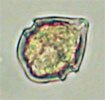
Scrippsiella trochoidea
|

Gonyaulax spinifera
|
|
This microscopic pincushion is a cyst, thick-walled dormant cell of dinophycean microalgae of genus Gonyaulax. When cold autumn storms come to Black Sea in November, many dinoflagellates transform their cell shape, switch their physiology into the hibernating mode, and fall to the bottom. Thick cell wall of the cyst is necessary for the protection from benthic predators, scavengers, and saprophytic bacteria. Cell wall of Gonyaulax cyst is additionally protected by the bristle of long spines. Dinophycean cysts are even capable of going through the digestive system of crustaceans or deritivourous fish like mullet and remain intact; they can spend years buried in bottom sediments and stay capable of germination. If currents raise cysts from the bottom, and the water temperature is high enough, germination ( excystment ) takes place: vegetative algal cell breaks off the cracked cyst's shell.
|

Gonyaulax cyst
|
|

Alexandrium excystment,
Utrish, Caucasian coast,
Feb. 2002
|
Massive excystment of dinoflagellate of genus Alexandrium occurred in Utrish near Anapa in February 2002. The sea storm disturbed bottom at the 30m depth, and apparently raised cysts resting in the silt. The weather was unusually warm for the winter and Alexandrium cells concentration in seawater reached 4000 cells per liter in several days. The coat of the cyst seen at this micrograph is already very thin, it is going to break, and vegetative algal cell is coming out. This way dinoflagellate bloom can occur due to the massive cyst germination, not to algal cells' proliferation as it happen usually.
Alexandrium species are of special importance for us for many of them can produce potent toxins of saxitoxin group (like in scorpions, and in tetraodontid fishes). Mussels feeding on the phytoplankton containing Alexandrium cells accumulate toxins, and consumption of such shellfish can cause a possibly lethal disease called paralytic shellfish poisoning.
|
Dinoflagellates are unusual algae: many of them can feed like animals, absorbing dissolved organic substances from seawater, or even ingesting detritus particles and plankton cells. Some of those dinophyceans retain photosynthetic activity, they are called myxotrophs, that is the case of the Ceratium species. There are dinoflagellates that do not have chloroplasts at all, they are complete heterotrophs; among such algae-animals are large species of genera Dinophysis and Protoperidinium. Huge dinoflagellates of genus Noctiluca are even accounted as zooplankton. The size of Noctiluca cells reaching 1.5 mm allows it devouring even larvae of animals.
|
Heterotrophic Protoperidinium have a special part of the antapical cell surface acting as gullet turning out to swallow food, smaller cells and organic particles. A predatory algae.
According to their genetic relationships, these organisms are plants; according to their ecological niche they are similar to animals. Still during marine ecological studies most heterotrophic dinoflagellates are accounted as phytoplankton.
There are also heterotrophic dinoflagellates that are parasites of other algae.
|

Protoperidinium granii
|
|
Dinoflagellates appear in plankton net samples from Black Sea in early spring, and reach their highest concentration in August and September; they almost completely disappear from plankton to the end of autumn.
|
|

Achnantes brevipes
|
Diatoms, class Bacillariophyceae. Cells of these algae are coated in ornate silicon frustules, like boxes with covers (diatom is consisting of two parts in Greek). When diatom cell divides, each daughter cell retain one half of the parent outer carcass. This is a side view of the colony of a large diatom Achnantes, it is possible to discern the two parts of the frustule even with the average light microscope. Achnantes is a benthic diatom living on underwater surfaces to the depth where sunlight reaches; currents and waves disturbing bottom sediments and macroalgae, often raise it into plankton community.
|
|
Here are several other common benthic diatoms of the Black Sea coastal waters; they also are usual temporary participants of the plankton community near shore. The shape and intracellular distribution of chloroplasts visible through the thin frustule, as well as the shape and ornamentation of the frustule itself, are the identification characters used in the light microscopic studies of phytoplankton.
|
|

Licmophora gracilis
|

Grammatophora marina
|
|

Pleurosigma elongatum
|

Thalassionema costatum
|
|
There are many pores - slots and holes - can be seen in the large frustules of Achnantes and Licmophora: they provide the exchange of dissolved matter between the cell and its environment. Because of the massive perforation, the diatom silicon thecae can be more correctly compared to lattice cages, then boxes. Even better these well ordered apertures can be seen in the scanning electron microscopic images of marine diatom frustules:
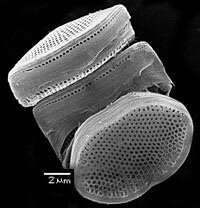  
Left: benthic diatom Achnantes; Right: large planktonic diatom Coscinodiscus;
Middle: A portion of the frustule of Pseudosolenia calcar-avis, the largest planktonic diatom in the Black Sea.
|
|
This is another, very nice bentho-planktonic diatom common in the Black Sea: Striatella. Its radiant chloroplast, the antenna for capturing the sunlight, itself looks like sun.
|

Striatella unipunctata
|
The most common and abundant marine planktonic diatoms are species of the genus Chaetoceros. They can be found in any part of the World Ocean, and they almost always represent a substantial (often - the dominant) portion of the phytoplankton in the Black Sea. Chaetoceros cells bear four long spines called chaeta, and usually are associated in chain-type colonies.
Chaeta form defense for Chaetoceros cells, they are effective even against big animals. Mussels in Black sea were observed to close their valves and stop feeding when Chaetoceros concentration in seawater was very high (tens of thousand cells or more), thus protecting their internal organs from sharp chaeta.
|
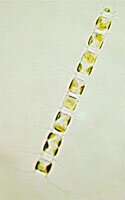
Chaetoceros compressus
|

Chaetoceros laciniosus can be distinguished by terminal pairs of chaetae reminding forceps
|

Chaetoceros curvisetus - most common diatom in the Black Sea
|
|

Pseudosolenia calcar-avis
|
Pseudosolenia calcar-avis is the largest planktonic diatom of the Black Sea, its length may exceed 1 mm. Sharp curved ends of the frustule prompted botanists to give this algae its species name: bird's spur - calcar-avis.
Despite its very large size and the silicon frustule weight, Pseudosolenia does not sink fast: due to the high surface-to-volume ratio it sails the currents in the water.
Planktonic diatoms having no flagella, and incapable of active locomotion are left the only way of struggling sinking: reducing the volume to surface ratio - increasing the windage of their cells. That is reached by an elongated (like in Pseudosolenia or Nitzschia) or flattened (Coscinodiscus) cell shape, frustule projections (chaeta of Chaetoceros), and colony formation. In most Chaetoceros species the daughter cells emerging after the mother cell division remain conjunct - this way the colony chain grows. Chaetoceros socialis cells excrete mucous mass that holds ball-shaped colony of this species together.
|
Chain colonies are most common in diatoms. Hemiaulus builds ladder-like chains, each cell division adds another step to this ladder:
|
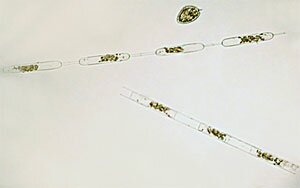
Hemiaulus hauckii colonies
|
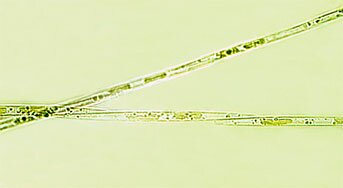
Colonies of Pseudonitzschia pseudodelicatissima
|
Pseudonitzschia also build colonies: needle-shaped cells are connected at the ends forming long threads. This small diatom is a very illustrative example of an opportunistic species, it is capable of explosive proliferation resulting in algal bloom when environmental conditions are most unfavorable for the majority of the other phytoplankton species. It can produce population outbursts in the middle of the winter, or during the summer depression of phytoplankton. Using minimal available resources, this tiny - 1-2 μm thick and 20 μm long - diatom grows and divides very quickly.
The smaller is the cell, the larger is its surface as related to its volume, and consequently higher the rate of matter exchange between the cell and its environment. It means a higher rate of mineral nutrient consumption, and higher rate of excretion, and this is a secret both of higher growth rate, and faster proliferation of the smallest cells of phyto- and bacterioplankton.
Because of that, the smallest phytoplankton cells make main contribution to renewal of the living matter in the Sea. They are cells less then 20 μm in size, and they are further divided into the two size groups:
nanoplankton - their cells' size ranges from 2 to 20 μm, and picoplankton, cell size < 2 μm.
Nano- and picophytoplankton cells contain more chlorophyll per mass unit then larger phytoplankton cells, which adds to their photosynthetic activity and correspondingly growth rate. They are barely visible using conventional light microscopes, and only when they are alive. When dead - they are impossible to tell from detritus particles. They are also impossible to catch using a plankton net: they pass trough the most dense 10μm gauze. Because of those technical reasons the role of the nanophytoplankton was underestimated for a long time; researchers paid more attention to the larger microplankton (cells >20μm) which includes most diatoms and dinoflagellates. Nanophytoplankton in the Black Sea includes, among others, coccolithophores and silicoflagellates which are referred to below.
There are very few algae in the winter phytoplankton in Black Sea coastal waters. As the spring comes with the growing amount of sunlight and growing water temperature, the Sea start to enliven.
First - the smallest algae of nanoplankton appear: tiny naked flagellates, coccolithophores, and small diatoms (often Pseudonitzschia pseudodelicatissima is starting the annual diatom succession).
further - Chaetoceros species follow, and larger diatoms;
later - turn of large dinoflagellates comes;
then - zooplankton consume almost all phytoplankton.
From mid-May to mid-July phytoplankton proliferation is calming down, Chaetoceros species dominate microphytoplankton. This is a time when a new, summer-autumn phase of phytoplankton succession in the Black Sea starts. Like in the spring, this second cycle of the Black Sea planktonic life often begins with the proliferation of the smallest diatoms (Pseudonitzschia) and/or coccolithophores.
Most pronounced and prolonged phytoplankton peak takes place in August-September. With the autumn cooling of water phytoplankton concentration falls, and as November storms come the annual cycle of the phytoplankton succession in the Black Sea finishes. This is a way of phytoplankton succession common to the Central and Eastern Black Sea; marine life in the eutrophied Western Black Sea coastal waters is more dependent on the Danube, Dnieper and other large rivers' desalinating discharge, and its nutrient load.
It was noticed long ago that warm winters usually are followed by a more pronounced spring phytoplankton rise in the Black Sea. Cold winters, and even more - sudden cooling in spring, inhibit phytoplankton succession, sometimes erasing spring phytoplankton peak and decreasing by times the summer phytoplankton concentration.
|
Coccolithophores (bearing round stones in Greek) are very small (cell size 5-10 μm) - nanoplankton algae possessing two flagella and covered by round limestone plates called coccoliths.
They belong to the algal division Haptophyta (= Prymnesiophyta). They are so small that pass through the most dense mesh used in plankton nets; special filters with pores of 1-3 μm diameter are needed to concentrate them. Due to their small size coccolithophores are barely seen through the light microscope, still coccoliths can be seen - they make cell surface looking curly.
Emiliana huxleyi is the most ubiquitous coccolithophore in the World Ocean. That very small algae is famous due to its ability for explosive proliferation, and causing blooms over vast areas of water; for example almost whole surface of Indian ocean can be engulfed in the Emiliana bloom.
|

Coccolithophore
Syracosphaera sp.
|
|

Coccolithophore bloom, Black Sea,
13 June 2000
|
Summer blooms of Emiliana huxleyi and other coccolithophores occur in Black Sea almost each summer, particularly during the June to July period. This NASA satellite image taken on 13 June 2000 shows white coccolithophores bloom visualizing the pattern of surface circulation in the Black Sea at that moment. When the bloom is over, coccoliths fall to the bottom, forming layers of the limestone deposits.
Geologists found out that first layers of coccoliths on Black Sea bottom were deposited ca. 3500 years ago, when salinity in the Sea reached 11‰ after the connection of the Black Sea to Mediterranean basin was reestablished; coccolithophore blooms in Black Sea started at that time
( History of the Black Sea Ecosystem )
|
|

Meringia sp
|
Silicoflagellates or Dictyochophyñeaens (class Dictyochophyñeae ). Usually they are less abundant then diatoms or dinoflagellates. During the well expressed spring phytoplankton peak in the Black Sea, there can be many nice little cells with numerous sharp spicules - it's Dictyocha: unicellular algae with silicic carcass. Look at it using the scanning electron microscope. Siliceous framework of dictyochophyceans is intracellular, in contrast to the diatom's outer skeleton. Silicoflagellates can swim, they have 2 flagella. Here is another silicoflagellate from the Black Sea: Meringia.
|
|
Euglenas, (class Euglenophyceae ), relatives of green algae have no hard outer casing, they are protected only by layer of mucous excretion; euglenas swim using flagella. They appear in the Black Sea coastal waters only when the environmental conditions are specially favorable for them: decreased salinity and higher nutrients' concentration. Their population grows fast, then they disappear as fast as appeared - zooplankton grazes them. Those survived cover themselves by hard capsule and sink to the bottom; cysts will rest before the coincidence of the conditions favorable for them occur again. Euglenas possess simple photoreceptor eye, tiny red organelle within their cells, directing the algae to the surface water. This small green worm-like euglenophycean algae often appearing at our coast is Eutreptia lanowii.
|
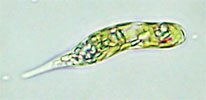
Eutreptia lanowii
|
|
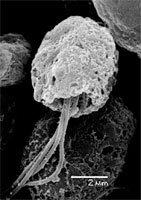
Four-flagellated cells of Prasinophycean algae from the near shore bloom north of Tuapse, Black Sea; SEM picture
|
Prasinophytes ( class Prasinophyceae, division Chlorophyta - green algae ) - small picoplankton cells having 1 to 8 flagella, covered by protective scales. Sometimes they cause algal blooms in coastal waters of the Black Sea, after heavy rains when water becomes brackish and eutrophied. Their role in the general ecology of the Black Sea is poorly investigated since they are almost impossible to identify and study with the use of the light microscope.
|
|
Another, much larger algae in our net sample: it's of brown-greenish color, it obviously lacks hard theca, and it's multicellular. This is a seedling of brown macroalgae, one of those that form bushy macrophyte belt at the rocky coasts of Black Sea; may be it's a beginning of an underwater 'tree' of Cystoseira barbata, the dominant brown algae in the Black Sea. At the moment it consists of no more then dozen cells, it lives within plankton, and currents and waves can throw it on shore, it can be eaten by crustaceans. Reaching the age and size of recruitment, it needs to settle on the hard bottom nearshore; if it settles on the sandy bottom, it dyes. If the settlement stage of development is reached when the seedling is at the depth over 30 meters, it dies, for there is no light sufficient for brown algae growth at that depth in the Black Sea. Of thousands of such seedlings only several will settle, grow, and reach the age of reproduction.
|

Brown algae seedling
|
Studying plankton samples from the Black Sea we find something new all the time: species new to Black Sea phytoplankton occur each year. This is the result of both the continuing invasions of algal species from other parts of Ocean (Evolution of the Black Sea Ecosystem), and progress in research techniques, development of new methods and instruments - now we can see many details that were impossible to discern some 50 years ago.
Subtle details of astonishing architecture of phytoplankton cells can be discovered with use of the scanning electron microscope. Cells of dinoflagellates and diatoms, having hard outer skeleton are most beautiful, and they are better preserved during the preparation procedure.
Black Sea phytoplankton - scanning electron microscope images
The following pages are available only in Russian:
Black Sea Marine Life - sandy bottom habitats - fishes, crabs, mollusks...
Black Sea Marine Life - sandy bottom habitats - let's think about it
Black Sea Marine Life - submarine rocks - near the surfline
Black Sea Marine Life - submarine rocks - deeper
Black Sea Marine Life - submarine rocks - even deeper
Oil pollution, coastal deforestation, etc.
Aegean Sea - compare to Black Sea
|
|

